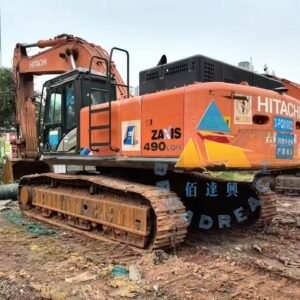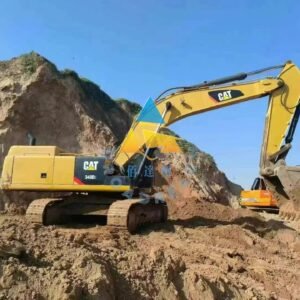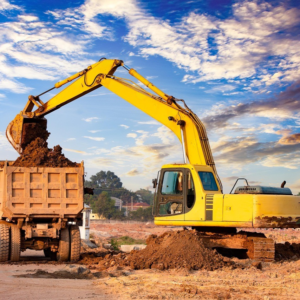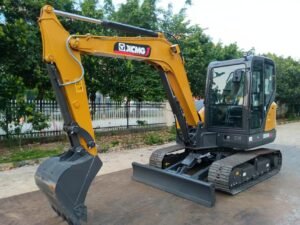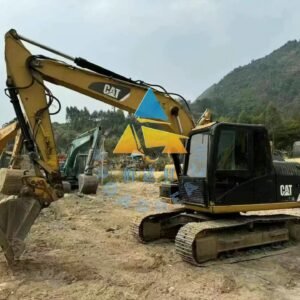BroadReach Construction Machinery Co., Ltd

Backhoe vs Excavator: Which Heavy Equipment is Right for Your Project?
When it comes to construction, landscaping, or any project involving heavy digging, two machines often come to mind: the backhoe and the excavator. Both are powerful, versatile machines designed to move earth and dig trenches, but they have different features and are better suited to specific tasks. So, how do you decide which one is right for your job? Let’s break down the differences, advantages, and ideal uses for each machine, so you can make an informed choice.
1. What is a Backhoe?
A backhoe is a compact and versatile machine often used for digging, lifting, and loading. It’s a type of tractor with a digging bucket at the rear (the “back” part) and a loader bucket at the front. This makes it a two-in-one machine, capable of performing both digging and lifting tasks.
Key Features of a Backhoe:
- Size: Smaller and more compact than an excavator, which makes it more maneuverable in tight spaces.
- Design: The backhoe has a bucket at the back for digging and a front loader for scooping and carrying materials.
- Flexibility: Ideal for smaller-scale projects, backhoes are commonly used in residential and light construction applications.
- Cost-Effective: Typically more affordable than excavators, both in terms of purchase price and operating costs.
Best for:
- Landscaping projects
- Utility work (e.g., trenching for pipes or cables)
- Smaller construction sites
- Tight spaces where maneuverability is important
2. What is an Excavator?
An excavator, often referred to as a “digger,” is a larger and more powerful machine designed specifically for digging, lifting, and moving heavy materials. Excavators come in various sizes, but they all share a characteristic long boom arm with a bucket at the end. This design allows for digging deep holes, lifting heavy objects, and performing tough tasks in a wide range of environments.
Key Features of an Excavator:
- Size: Excavators are typically larger than backhoes, making them ideal for big jobs that require extensive digging and lifting.
- Design: Excavators have a long arm and a bucket that can extend over obstacles, giving them greater reach and digging depth than a backhoe.
- Power: They’re designed to handle heavy-duty tasks and can dig deeper and move more material compared to backhoes.
- Stability: Excavators are built to be stable, especially when performing tasks like deep digging or lifting heavy loads.
Best for:
- Large construction and mining projects
- Demolition work
- Deep digging and trenching
- Jobs that require heavy lifting and moving large amounts of dirt or debris
3. Backhoe vs Excavator: Key Differences
Here’s a quick comparison to help you better understand the core differences between the two machines:
| Feature | Backhoe | Excavator |
|---|---|---|
| Size | Smaller, compact, easy to maneuver | Larger, more powerful, and less maneuverable |
| Digging Depth | Shallow to moderate depth (usually up to 14 feet) | Deeper digging capability (up to 30 feet or more) |
| Bucket Reach | Shorter reach, ideal for shallow tasks | Long arm with excellent reach and flexibility |
| Ideal Tasks | Landscaping, trenching, digging in tight areas | Heavy-duty digging, demolition, and large projects |
| Price | Generally less expensive | More expensive, especially for larger models |
| Versatility | Versatile (can load, lift, and dig) | Best suited for digging and lifting only |
4. When to Use a Backhoe
A backhoe is a great option when you need a versatile machine for a variety of smaller tasks. It’s ideal for residential landscaping, trenching for utilities, and even some excavation jobs that don’t require deep digging. Here are some scenarios where a backhoe shines:
- Landscaping Projects: If you’re digging small trenches for pipes or laying foundations for garden walls, the backhoe’s compact size and dual functionality (digging and loading) make it a great fit.
- Utility Work: Backhoes are perfect for digging up and installing utilities like gas lines, water pipes, and electrical cables. They’re small enough to fit in tight spaces and maneuver around existing infrastructure.
- Tight Spaces: If your project is in a confined area or has limited space for maneuvering, a backhoe can often get the job done more easily than an excavator.
5. When to Use an Excavator
An excavator is built for tougher jobs, especially those that require heavy-duty digging, lifting, or moving large amounts of material. Here are a few examples where an excavator would be the better choice:
- Construction Projects: Whether you’re digging foundations for a large building or clearing land for a new development, an excavator can handle deeper digging and more demanding tasks.
- Demolition: Excavators are commonly used in demolition work, as they can break down structures and move debris with ease.
- Mining and Quarry Work: For large-scale earth-moving tasks, such as in mining or quarry operations, excavators are designed to handle massive loads of dirt, rock, and other materials.
- Heavy Lifting: Excavators are also capable of lifting and transporting large, heavy objects, making them ideal for tasks like removing boulders or moving heavy equipment.
6. Making Your Choice: Backhoe or Excavator?
Ultimately, the decision between a backhoe and an excavator comes down to the size and scope of your project, as well as your specific needs. Here’s a quick guide to help you decide:
- Go for a backhoe if:
- You need a compact, versatile machine for light to moderate digging.
- Your project is on a smaller scale, such as residential or landscaping work.
- You need a machine that can handle both digging and loading tasks in tight spaces.
- Go for an excavator if:
- Your project involves heavy-duty digging, lifting, or deep trenching.
- You’re working on a large-scale construction or demolition project.
- You need a machine with more power and reach for handling heavy loads.
Conclusion
Both backhoes and excavators are essential pieces of equipment in the construction world, each offering its own unique set of advantages. A backhoe is perfect for smaller, more versatile tasks, while an excavator is designed to take on large, tough projects that require more power and depth. By considering the size and complexity of your job, you can choose the machine that will help you get the job done efficiently, saving both time and money.

